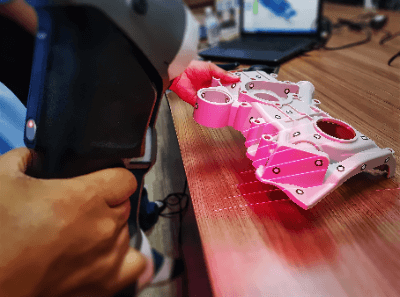What Is a 3D Scanner?

A 3D Scanner is a device used to perform 3D scanning.
3D scanning refers to the technology of collecting shape-related data from real-world objects and environments to build digital 3D models. A 3D Scanner is a device that converts objects into digital data, while a 3D Printer is a device that converts digital data into objects.
Uses of 3D Scanners
3D Scanners are widely used in the manufacturing industry. First, they are useful as quality inspection tools. Industrial product inspections require dimensional measurements using a variety of measuring instruments. However, the use of multiple measuring instruments requires skill to handle each instrument and a lot of time to perform the measurement process.
By using a 3D Scanner to create 3D data of the inspection object, it is possible to take dimensional measurements of even complex parts on the digital data. It is also possible to compare the 3D data with the designed 3D model. In addition to quality inspection, 3D Scanners are also used in reverse engineering.
Reverse engineering is used for various analyses because 3D data can be obtained from the actual product. By creating 3D data from competitors’ products for which design data is not available, structural analysis can be performed and comparisons can be made with the company’s own products.
Outside of the manufacturing industry, 3D data is used for digital archiving of historical and cultural assets. Valuable stone monuments, for example, can be preserved as 3D data. In addition, entertainment applications such as animation, film, and video game production are also industries where 3D Scanners are used.
Principle of 3D Scanner
First of all, there are contact and non-contact 3D Scanners, and there are several non-contact methods. Here we explain the principles of the three most common methods.
1. Contact 3D Scanner
A contact 3D Scanner converts the shape into coordinate data by bringing a probe into contact with the object. Although the measurement accuracy is high because of the direct contact with the object, a relatively long measurement time is required. Another disadvantage is that some shapes cannot be penetrated by the probe, but contact 3D Scanners are used for objects that cannot be measured by non-contact methods.
2. Laser Beam Method
The laser beam method is a non-contact 3D Scanner that measures an object by irradiating a laser beam onto it. There are three main types of laser beam methods: triangulation, time-of-flight (TOF), and phase detection.
The triangulation method is highly accurate and suitable for measuring a narrow area, while the time-of-flight method is suitable for measuring a wide area. The phase difference method, also called the phase shift method, provides a large amount of point cloud data in a relatively short period of time, but tends to produce a large amount of data from diffusely reflected lasers as noise.
3. Pattern Light Projection Method
The patterned light projection method is another principle used in non-contact 3D Scanners. This method projects a stripe pattern light from the scanner onto the object and obtains 3D data from the reflected light that changes according to the shape of the object. Since the light source is not laser light but LED, it can be used on the human body and color information can be obtained, so it is relatively widely used.
Other Information on 3D Scanners
Accuracy of 3D Scanner
3D Scanners create 3D scans of objects, but they do not always reproduce the object perfectly. 3D Scanner errors occur in the position of the object’s point cloud and the distance between the point clouds.
Products are labeled with an accuracy indicator, so it is important to select a product according to the acceptable margin of error. Naturally, high-precision products are more expensive, but some products allow multiple measurements to compensate for errors.
Polygon data created by a 3D Scanner can also be manually combined to increase accuracy. Polygon data is data created with surface elements. Experience is important for this process, as it is necessary to know how to improve the accuracy best suited to the object.